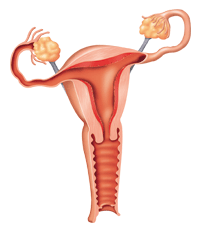The female genital tract consists of the ovaries (which contain the egg cells and cells which produce hormones such as oestrogen and progesterone); the fallopian tubes (which provide a pathway for the egg between the ovary and the uterus, and where fertilisation usually occurs); the uterus, or womb (designed for the development of the foetus); the vagina (via which, under normal circumstances, sperm is introduced during intercourse to fertilise the egg, and via which the baby is born), and the vulva, which constitutes what’s called the “external genitalia” - the only part visible to most of us - consisting of two thin folds of skin called the labia minora, and two thicker, outer, hair-bearing folds called the labia majora. The clitoris is a button of tissue which sits at the apex of the vulva, where the labia minora join together, which becomes erect due to increased blood flow during sexual arousal, and is analogous to the male penis. The bottom of the vulva is separated from the anus by a firm block of tissue called the perineal body. The whole of the area between this at the bottom and the clitoris at the top is called the perineum (because it’s this which is around the baby - or neonate - at birth). The vagina is a muscular tube connecting the cervix of the uterus with the outside world, about 7 cm deep at the front and 10cm at the back. It is sufficiently elastic to accommodate childbirth and has a mucosal lining which is lubricated partly by mucous secreted by the cervix - which changes and increases at ovulation - and partly by fluid from blood vessels below its surface, a process called transudation, which is increased during sexual arousal, and decreases after the menopause. The front wall of the vagina constitutes the back wall of the bladder and the tube - the urethra - which runs from the bladder to open just below the clitoris, lies within it. Since the angle at which the urethra leaves the bladder is an important factor in maintaining urinary continence (see the kidney in the genito-urinary system) the tone of the muscle in the front wall of the vagina is a matter of importance to all women, particularly after childbirth (so, ladies, do your pelvic floor exercises). The floor of the vagina lays against the front wall of the rectum. | |||
 | This information is licensed for use by Wellbeing Information Systems Ltd ("WIS"), and protected by international copyright law. All rights are reserved. (email info@wisinfo.co.uk). |
